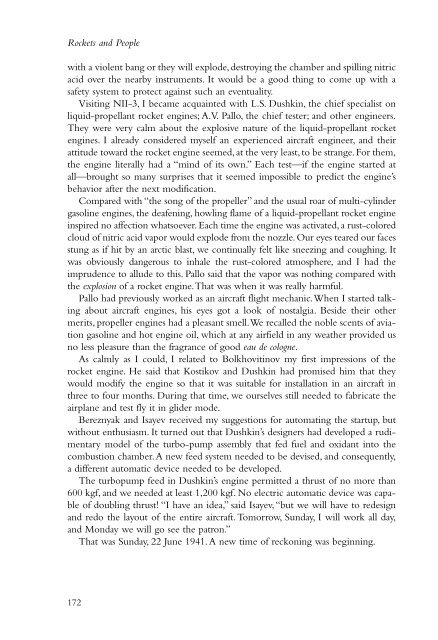to open next chapter. - NASA's History Office
to open next chapter. - NASA's History Office
to open next chapter. - NASA's History Office
Create successful ePaper yourself
Turn your PDF publications into a flip-book with our unique Google optimized e-Paper software.
Rockets and People<br />
with a violent bang or they will explode, destroying the chamber and spilling nitric<br />
acid over the nearby instruments. It would be a good thing <strong>to</strong> come up with a<br />
safety system <strong>to</strong> protect against such an eventuality.<br />
Visiting NII-3, I became acquainted with L.S. Dushkin, the chief specialist on<br />
liquid-propellant rocket engines; A.V. Pallo, the chief tester; and other engineers.<br />
They were very calm about the explosive nature of the liquid-propellant rocket<br />
engines. I already considered myself an experienced aircraft engineer, and their<br />
attitude <strong>to</strong>ward the rocket engine seemed, at the very least, <strong>to</strong> be strange. For them,<br />
the engine literally had a “mind of its own.” Each test—if the engine started at<br />
all—brought so many surprises that it seemed impossible <strong>to</strong> predict the engine’s<br />
behavior after the <strong>next</strong> modification.<br />
Compared with “the song of the propeller” and the usual roar of multi-cylinder<br />
gasoline engines, the deafening, howling flame of a liquid-propellant rocket engine<br />
inspired no affection whatsoever. Each time the engine was activated, a rust-colored<br />
cloud of nitric acid vapor would explode from the nozzle. Our eyes teared our faces<br />
stung as if hit by an arctic blast, we continually felt like sneezing and coughing. It<br />
was obviously dangerous <strong>to</strong> inhale the rust-colored atmosphere, and I had the<br />
imprudence <strong>to</strong> allude <strong>to</strong> this. Pallo said that the vapor was nothing compared with<br />
the explosion of a rocket engine.That was when it was really harmful.<br />
Pallo had previously worked as an aircraft flight mechanic.When I started talking<br />
about aircraft engines, his eyes got a look of nostalgia. Beside their other<br />
merits, propeller engines had a pleasant smell.We recalled the noble scents of aviation<br />
gasoline and hot engine oil, which at any airfield in any weather provided us<br />
no less pleasure than the fragrance of good eau de cologne.<br />
As calmly as I could, I related <strong>to</strong> Bolkhovitinov my first impressions of the<br />
rocket engine. He said that Kostikov and Dushkin had promised him that they<br />
would modify the engine so that it was suitable for installation in an aircraft in<br />
three <strong>to</strong> four months. During that time, we ourselves still needed <strong>to</strong> fabricate the<br />
airplane and test fly it in glider mode.<br />
Bereznyak and Isayev received my suggestions for au<strong>to</strong>mating the startup, but<br />
without enthusiasm. It turned out that Dushkin’s designers had developed a rudimentary<br />
model of the turbo-pump assembly that fed fuel and oxidant in<strong>to</strong> the<br />
combustion chamber.A new feed system needed <strong>to</strong> be devised, and consequently,<br />
a different au<strong>to</strong>matic device needed <strong>to</strong> be developed.<br />
The turbopump feed in Dushkin’s engine permitted a thrust of no more than<br />
600 kgf, and we needed at least 1,200 kgf. No electric au<strong>to</strong>matic device was capable<br />
of doubling thrust! “I have an idea,” said Isayev,“but we will have <strong>to</strong> redesign<br />
and redo the layout of the entire aircraft. Tomorrow, Sunday, I will work all day,<br />
and Monday we will go see the patron.”<br />
That was Sunday, 22 June 1941.A new time of reckoning was beginning.<br />
172
















